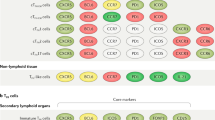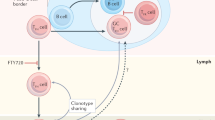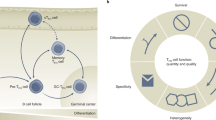Abstract
T follicular helper (Tfh) cells were discovered just over a decade ago as germinal centre T cells that help B cells make antibodies. Included in this role is affinity maturation and isotype switching. It is here that their functions become less clear. Tfh cells principally produce IL-21 which inhibits class switching to IgE. Recent studies have questioned whether the germinal centre is the main site of IgE class switching or IgE affinity maturation. In this review, I will examine the evidence that these cells are responsible for regulating IgE class switching and the relationship between Tfh cells and T helper 2 (Th2) effector cells.
This is a preview of subscription content, access via your institution
Access options
Subscribe to this journal
Receive 12 digital issues and online access to articles
$119.00 per year
only $9.92 per issue
Buy this article
- Purchase on Springer Link
- Instant access to full article PDF
Prices may be subject to local taxes which are calculated during checkout


Similar content being viewed by others
References
Mosmann TR, Cherwinski H, Bond MW, Giedlin MA, Coffman RL . Two types of murine helper T cell clone. I. Definition according to profiles of lymphokine activities and secreted proteins. J Immunoly 1986; 136: 2348–2357.
Cher DJ, Mosmann TR . Two types of murine helper T cell clone. II. Delayed-type hypersensitivity is mediated by TH1 clones. J Immunol 1987; 138: 3688–3694.
Walker LS, Gulbranson-Judge A, Flynn S, Brocker T, Raykundalia C, Goodall M et al. Compromised OX40 function in CD28-deficient mice is linked with failure to develop CXC chemokine receptor 5-positive CD4 cells and germinal centers. J Exp Med 1999; 190: 1115–122.
Schaerli P, Willimann K, Lang AB, Lipp M, Loetscher P, Moser B . CXC chemokine receptor 5 expression defines follicular homing T cells with B cell helper function. J Exp Med 2000; 192: 1553–1562.
Kim CH, Rott LS, Clark-Lewis I, Campbell DJ, Wu L, Butcher EC . Subspecialization of CXCR5+ T cells: B helper activity is focused in a germinal center-localized subset of CXCR5+ T cells. J Exp Med 2001; 193: 1373–1381.
Chtanova T, Tangye SG, Newton R, Frank N, Hodge MR, Rolph MS et al. T follicular helper cells express a distinctive transcriptional profile, reflecting their role as non-Th1/Th2 effector cells that provide help for B cells. J Immunol 2004; 173: 68–78.
Breitfeld D, Ohl L, Kremmer E, Ellwart J, Sallusto F, Lipp M et al. Follicular B helper T cells express CXC chemokine receptor 5, localize to B cell follicles, and support immunoglobulin production. J Exp Med 2000; 192: 1545–1552.
Bossaller L, Burger J, Draeger R, Grimbacher B, Knoth R, Plebani A et al. ICOS deficiency is associated with a severe reduction of CXCR5+CD4 germinal center Th cells. J Immunol 2006; 177: 4927–4932.
Vogelzang A, McGuire HM, Yu D, Sprent J, Mackay CR, King C . A fundamental role for interleukin-21 in the generation of T follicular helper cells. Immunity 2008; 29: 127–137.
Butch AW, Chung GH, Hoffmann JW, Nahm MH . Cytokine expression by germinal center cells. J Immunol 1993; 150: 39–47.
Liang HE, Reinhardt RL, Bando JK, Sullivan BM, Ho IC, Locksley RM . Divergent expression patterns of IL-4 and IL-13 define unique functions in allergic immunity. Nat Immunol 2012; 13: 58–66.
Tanaka S, Tsukada J, Suzuki W, Hayashi K, Tanigaki K, Tsuji M et al. The interleukin-4 enhancer CNS-2 is regulated by Notch signals and controls initial expression in NKT cells and memory-type CD4 T cells. Immunity 2006; 24: 689–701.
Harada Y, Tanaka S, Motomura Y, Harada Y, Ohno S, Ohno S et al. The 3′ enhancer CNS2 is a critical regulator of interleukin-4-mediated humoral immunity in follicular helper T cells. Immunity 2012; 36: 188–200.
Yu D, Rao S, Tsai LM, Lee SK, He Y, Sutcliffe EL et al. The transcriptional repressor Bcl-6 directs T follicular helper cell lineage commitment. Immunity 2009; 31: 457–468.
Watanabe A, Mishima H, Renzi PM, Xu LJ, Hamid Q, Martin JG . Transfer of allergic airway responses with antigen-primed CD4+ but not CD8+ T cells in Brown Norway rats. J Clin Invest 1995; 96: 1303–1310.
Haczku A, Macary P, Haddad EB, Huang TJ, Kemeny DM, Moqbel R et al. Expression of Th-2 cytokines interleukin-4 and -5 and of Th-1 cytokine interferon-gamma in ovalbumin-exposed sensitized Brown–Norway rats. Immunology 1996; 88: 247–251.
Haczku A, Macary P, Huang TJ, Tsukagoshi H, Barnes PJ, Kay AB et al. Adoptive transfer of allergen-specific CD4− T cells induces airway inflammation and hyperresponsiveness in Brown–Norway rats. Immunology 1997; 91: 176–185.
Kaminuma O, Mori A, Ogawa K, Nakata A, Kikkawa H, Naito K et al. Successful transfer of late phase eosinophil infiltration in the lung by infusion of helper T cell clones. Am J Respir Cell Mol Biol 1997; 16: 448–454.
Cohn L, Homer RJ, Marinov A, Rankin J, Bottomly K . Induction of airway mucus production By T helper 2 (Th2) cells: a critical role for interleukin 4 in cell recruitment but not mucus production. J Exp Med 1997; 186: 1737–1747.
Hogan SP, Koskinen A, Matthaei KI, Young IG, Foster PS . Interleukin-5-producing CD4+ T cells play a pivotal role in aeroallergen-induced eosinophilia, bronchial hyperreactivity, and lung damage in mice. Am J Respir Crit Care Med 1998; 157: 210–218.
Mattes J, Yang M, Siqueira A, Clark K, MacKenzie J, McKenzie AN et al. IL-13 induces airways hyperreactivity independently of the IL-4R alpha chain in the allergic lung. J Immunol 2001; 167: 1683–1692.
Gauchat JF, Lebman DA, Coffman RL, Gascan H, de Vries JE . Structure and expression of germline epsilon transcripts in human B cells induced by interleukin 4 to switch to IgE production. J Exp Med 1990; 172: 463–473.
Armitage RJ, Fanslow WC, Strockbine L, Sato TA, Clifford KN, Macduff BM et al. Molecular and biological characterization of a murine ligand for CD40. Nature 1992; 357: 80–82.
Coffman RL, Carty J . A T cell activity that enhances polyclonal IgE production and its inhibition by interferon-gamma. J Immunol 1986; 136: 949–954.
Kawano Y, Noma T, Yata J . Regulation of human IgG subclass production by cytokines. IFN-gamma and IL-6 act antagonistically in the induction of human IgG1 but additively in the induction of IgG2. J Immunol 1994; 153: 4948–4958.
Snapper CM, Paul WE . Interferon-gamma and B cell stimulatory factor-1 reciprocally regulate Ig isotype production. Science 1987; 236: 944–947.
Kim PH, Kagnoff MF . Transforming growth factor beta 1 increases IgA isotype switching at the clonal level. J Immunol 1990; 145: 3773–3778.
Jeannin P, Lecoanet S, Delneste Y, Gauchat JF, Bonnefoy JY . IgE versus IgG4 production can be differentially regulated by IL-10. J Immunol 1998; 160: 3555–3561.
Pene J, Gauchat JF, Lecart S, Drouet E, Guglielmi P, Boulay V et al. Cutting edge: IL-21 is a switch factor for the production of IgG1 and IgG3 by human B cells. J Immunol 2004; 172: 5154–5157.
Luthje K, Kallies A, Shimohakamada Y, Belz GT, Light A, Tarlinton DM et al. The development and fate of follicular helper T cells defined by an IL-21 reporter mouse. Nat Immunol 2012; 13: 491–498.
Tsuji M, Komatsu N, Kawamoto S, Suzuki K, Kanagawa O, Honjo T et al. Preferential generation of follicular B helper T cells from Foxp3+ T cells in gut Peyer's patches. Science 2009; 323: 1488–1492.
McMenamin C, Girn B, Holt PG . The distribution of IgE plasma cells in lymphoid and non-lymphoid tissues of high-IgE responder rats: differential localization of antigen-specific and ‘bystander’ components of the IgE response to inhaled antigen. Immunology 1992; 77: 592–596.
Platts-Mills TA . Local production of IgG, IgA and IgE antibodies in grass pollen hay fever. J Immunol 1979; 122: 2218–2225.
Tuft SJ, Dart JK, Kemeny M . Limbal vernal keratoconjunctivitis: clinical characteristics and immunoglobulin E expression compared with palpebral vernal. Eye 1989; 3: 420–427.
Gleich GJ, Zimmermann EM, Henderson LL, Yunginger JW . Effect of immunotherapy on immunoglobulin E and immunoglobulin G antibodies to ragweed antigens: a six-year prospective study. J Allergy Clin Immunol 1982; 70: 261–271.
Nurieva RI, Chung Y, Hwang D, Yang XO, Kang HS, Ma L et al. Generation of T follicular helper cells is mediated by interleukin-21 but independent of T helper 1, 2, or 17 cell lineages. Immunity 2008; 29: 138–149.
Ozaki K, Spolski R, Feng CG, Qi CF, Cheng J, Sher A et al. A critical role for IL-21 in regulating immunoglobulin production. Science 2002; 298: 1630–1634.
Shang XZ, Ma KY, Radewonuk J, Li J, Song XY, Griswold DE et al. IgE isotype switch and IgE production are enhanced in IL-21-deficient but not IFN-gamma-deficient mice in a Th2-biased response. Cell Immunol 2006; 241: 66–74.
Hiromura Y, Kishida T, Nakano H, Hama T, Imanishi J, Hisa Y et al. IL-21 administration into the nostril alleviates murine allergic rhinitis. J Immunol 2007; 179: 7157–7165.
Suto A, Nakajima H, Hirose K, Suzuki K, Kagami S, Seto Y et al. Interleukin 21 prevents antigen-induced IgE production by inhibiting germ line C(epsilon) transcription of IL-4-stimulated B cells. Blood 2002; 100: 4565–4573.
Kobayashi S, Haruo N, Sugane K, Ochs HD, Agematsu K . Interleukin-21 stimulates B-cell immunoglobulin E synthesis in human beings concomitantly with activation-induced cytidine deaminase expression and differentiation into plasma cells. Hum Immunol 2009; 70: 35–40.
Avery DT, Ma CS, Bryant VL, Santner-Nanan B, Nanan R, Wong M et al. STAT3 is required for IL-21-induced secretion of IgE from human naive B cells. Blood 2008; 112: 1784–1793.
Erazo A, Kutchukhidze N, Leung M, Christ AP, Urban JF Jr, Curotto de Lafaille MA et al. Unique maturation program of the IgE response in vivo. Immunity 2007; 26: 191–203.
Xiong H, Dolpady J, Wabl M, Curotto de Lafaille MA, Lafaille JJ . Sequential class switching is required for the generation of high affinity IgE antibodies. J Exp Med 2012; 209: 353–364.
Wesemann DR, Magee JM, Boboila C, Calado DP, Gallagher MP, Portuguese AJ et al. Immature B cells preferentially switch to IgE with increased direct Smu to Sepsilon recombination. J Exp Med 2011; 208: 2733–2746.
Pol E, Karlsson R, Roos H, Jansson A, Xu B, Larsson A et al. Biosensor-based characterization of serum antibodies during development of an anti-IgE immunotherapeutic against allergy and asthma. J Mol Recogn 2007; 20: 22–31.
Tsuruoka N, Arima M, Arguni E, Saito T, Kitayama D, Sakamoto A et al. Bcl6 is required for the IL-4-mediated rescue of the B cells from apoptosis induced by IL-21. Immunol Lett 2007; 110: 145–151.
Kitayama D, Sakamoto A, Arima M, Hatano M, Miyazaki M, Tokuhisa T . A role for Bcl6 in sequential class switch recombination to IgE in B cells stimulated with IL-4 and IL-21. Mol Immunol 2008; 45: 1337–1345.
Talay O, Yan D, Brightbill HD, Straney EE, Zhou M, Ladi E et al. IgE+ memory B cells and plasma cells generated through a germinal-center pathway. Nat Immunol 2012; 13: 396–404.
Yang Z, Sullivan BM, Allen CD . Fluorescent in vivo detection reveals that IgE+ B cells are restrained by an intrinsic cell fate predisposition. Immunity 2012; 36: 857–872.
Nagai T, Ibata K, Park ES, Kubota M, Mikoshiba K, Miyawaki A . A variant of yellow fluorescent protein with fast and efficient maturation for cell-biological applications. Nat Biotechnol 2002; 20: 87–90.
Jung S, Siebenkotten G, Radbruch A . Frequency of immunoglobulin E class switching is autonomously determined and independent of prior switching to other classes. J Exp Med 1994; 179: 2023–2026.
Misaghi S, Garris CS, Sun Y, Nguyen A, Zhang J, Sebrell A et al. Increased targeting of donor switch region and IgE in Sgamma1-deficient B cells. J Immunol 2010; 185: 166–173.
Zhang K, Mills FC, Saxon A . Switch circles from IL-4-directed epsilon class switching from human B lymphocytes. Evidence for direct, sequential, and multiple step sequential switch from mu to epsilon Ig heavy chain gene. J Immunol 1994; 152: 3427–3435.
Baskin B, Islam KB, Evengard B, Emtestam L, Smith CI . Direct and sequential switching from mu to epsilon in patients with Schistosoma mansoni infection and atopic dermatitis. Eur J Immunol 1997; 27: 130–135.
Cameron L, Gounni AS, Frenkiel S, Lavigne F, Vercelli D, Hamid Q . S epsilon S mu and S epsilon S gamma switch circles in human nasal mucosa following ex vivo allergen challenge: evidence for direct as well as sequential class switch recombination. J Immunol 2003; 171: 3816–3822.
Watanabe N, Gavrieli M, Sedy JR, Yang J, Fallarino F, Loftin SK et al. BTLA is a lymphocyte inhibitory receptor with similarities to CTLA-4 and PD-1. Nat Immunol 2003; 4: 670–679.
Kashiwakuma D, Suto A, Hiramatsu Y, Ikeda K, Takatori H, Suzuki K et al. B and T lymphocyte attenuator suppresses IL-21 production from follicular Th cells and subsequent humoral immune responses. J Immunol 2010; 185: 2730–2736.
Dhanjal MK, Towler AE, Tuft S, Hetzel C, Richards D, Kemeny DM . The detection of IgE-secreting cells in the peripheral blood of patients with atopic dermatitis. J Allergy Clin Immunol 1992; 89: 895–904.
Ruiz RG, Kemeny DM, Price JF . Higher risk of infantile atopic dermatitis from maternal atopy than from paternal atopy. Clin Exp Allergy 1992; 22: 762–766.
Author information
Authors and Affiliations
Corresponding author
Rights and permissions
About this article
Cite this article
Kemeny, D. The role of the T follicular helper cells in allergic disease. Cell Mol Immunol 9, 386–389 (2012). https://doi.org/10.1038/cmi.2012.31
Received:
Revised:
Accepted:
Published:
Issue Date:
DOI: https://doi.org/10.1038/cmi.2012.31
Keywords
This article is cited by
-
Time-dependent cytokines changes in ultra-rush wasp venom immunotherapy
Scientific Reports (2023)
-
Asthma
Nature Reviews Disease Primers (2015)
-
IL-21 acts as a promising therapeutic target in systemic lupus erythematosus by regulating plasma cell differentiation
Cellular & Molecular Immunology (2015)
-
Follicular helper T cells in immune homeostasis
Cellular & Molecular Immunology (2012)



